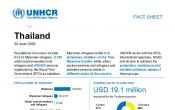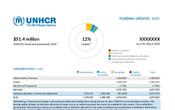Thailand
Operation: Thailand
Location
{"longitude":101,"latitude":16,"zoom_level":0,"iso_codes":"'THA'"}
By clicking on the icons on the map, additional information is displayed.
The boundaries and names shown and the designations used on this map do not imply official endorsement or acceptance by the United Nations.
Key Figures
| 2019 year-end results | |
| 17,600 | individuals in nine camps received training on sexual and gender-based violence (SGBV) prevention and response |
| 3,000 | nationality applications were submitted with support from UNHCR and its partners, and 9,600 individuals received legal assistance related to nationality and legal status issues |
| 2,800 | individuals departed for resettlement, and nearly 800 submissions for resettlement were made |
| 2,700 | birth certificates were issued to children in the nine camps on the Thai-Myanmar border |
| 2,200 | urban refugees benefited from cash-based interventions for emergency support or to address the basic needs of the most vulnerable individuals |
| 900 | refugees returned from Thailand to Myanmar (primarily in the south-east) in two facilitated return movements, while preparations continued for further returns |
| 2020 planning figures | |
| 10,000 | stateless persons will receive counselling and assistance to prepare citizenship applications |
| 5,000 | refugees from Myanmar will be assisted to return home |
| 2,750 | vulnerable urban refugees will be assisted through cash-based interventions to help them survive |
| 1,500 | refugee children from Myanmar will be registered and provided with birth certificates to facilitate their access to durable solutions |
| 665 | urban refugee children will be supported to enroll in Thai primary and secondary schools |
Latest Updates and Related Links
People of Concern
1%
Decrease in
2019
2019
| 2019 | 573,425 |
| 2018 | 582,130 |
| 2017 | 593,241 |

[["Refugees",50067],["Refugee-like situation",47504],["Asylum-seekers",847],["Stateless",475007]]
Loading ...
Thailand
< Back
2019
{"categories":[2015,2016,2017,2018,2019,2020],"budget":[38.36345908,30.69063927,33.24908962,22.93266875,19.58958646,19.06644567],"expenditure":[14.033841610000001,13.190506599999999,13.24290793,12.47772996,11.30750356,null]}
{"categories":[2015,2016,2017,2018,2019,2020],"p1":[37.165541850000004,29.10028416,32.074573550000004,21.89347811,18.669082420000002,17.71571023],"p2":[1.19791723,1.5903551100000002,1.1745160700000001,1.03919064,0.9205040400000001,1.35073544],"p3":[null,null,null,null,null,null],"p4":[null,null,null,null,null,null]}
{"categories":[2015,2016,2017,2018,2019,2020],"p1":[13.515990890000001,12.22130649,12.30524211,11.713327699999999,10.67308501,null],"p2":[0.51785072,0.96920011,0.93766582,0.76440226,0.63441855,null],"p3":[null,null,null,null,null,null],"p4":[null,null,null,null,null,null]}
Loading ...
CHOOSE A YEAR
- 2014
- 2015
- 2016
- 2017
- 2018
- 2019
- 2020
Operational context
Thailand, a middle-income country with a growing economy and considerable reliance on migrant workers, is both a country of transit and a country of destination for people on the move. Although it is not party to the 1951 Refugee Convention, asylum-seekers and refugees are permitted to remain temporarily on Thai territory; however any assistance and solutions remain the responsibility of humanitarian actors. Resettlement was pursued for the most vulnerable cases only.Progress was made on the protection framework in 2019, in line with the pledges made by the Government in the context of the 2016 Leaders’ Summit on Refugees and with additional pledges made at the Global Refugee Forum in December 2019. UNHCR supported the Governments of Thailand and Myanmar to develop a multi-solutions approach for refugees remaining in the nine camps on the Thai-Myanmar border. Host to one of the largest identified stateless populations in the world, Thailand also put in place progressive measures to address statelessness, including through legislative reforms and administrative measures.
Population trends
- Thailand hosted over 573,000 people of concern, including some 475,000 registered stateless individuals and 5,000 urban refugees and asylum-seekers from some 40 countries. There was a slight decrease in the number of refugees from Myanmar in camps on the border (93,300 including unregistered), primarily due to resettlement departures and small-scale voluntary repatriation, as well as a decrease the number of urban refugees.
- Some 6% of the urban refugee and asylum-seeker population were in detention by year end, while over 200 individuals - primarily children, mothers and people with serious medical conditions - were released on bail.
- Despite the deterioration of the situation in Rakhine State, Myanmar, since August 2017, the Rohingya population registered by UNHCR remained relatively low though increasing in Thailand. During 2019, more than 100 Rohingya were registered and another 100 new arrivals were recorded and processed for registration, more than double the number of arrivals that were registered in 2018. All individuals were detained in government facilities in different areas of Thailand.
Achievements
- In December, Thailand enacted a regulation establishing a screening mechanism to identify persons in need of international protection. UNHCR supported the Government to more closely align the regulation with international standards in view of enabling more predictable protection space.
- UNHCR supported Thailand in pursuing alternatives to immigration detention, enabling the release of over 50 refugee and asylum-seeking children and their mothers. By the end of the year, no children of concern to UNHCR were detained in the main immigration detention centre.
- Over 160 individuals underwent DNA testing with UNHCR support to determine family links. This is an important step in processing and resolving complex nationality applications of stateless persons.
- As part of UNHCR’s engagement with the refugee community on the Thai-Myanmar border, more than 5,700 refugees participated in outreach sessions to inform solutions to the situation of protracted encampment.
- The protection needs of more than 200 newly arrived Rohingya in Songkhla and Satun provinces were assessed, and the individuals were provided with non-food items in support of the efforts by the Thai authorities.
Unmet needs
- The operation was funded at 60% by the end of 2019.
- The increased need for protection counselling, resettlement interviews, and emergency assistance through cash-based interventions for children and mothers released from immigration detention could not be met adequately.
- Reduced monitoring of locations where Rohingya were detained delayed registration and protection assessments for newly arrived individuals.
- UNHCR could not meet all requests by the Thai authorities for DNA tests required for some stateless persons applying for citizenship.
- Plans for a youth volunteer programme to support the preparation of nationality applications could not be implemented due to lack of funding.
Working environment
Continued stability in parts of southeastern Myanmar as well as the simplification of the voluntary return process, is expected to lead to an increase in the number of facilitated voluntary returns of refugees residing in the nine camps on the border between Myanmar and Thailand.
Concrete developments with respect to key pledges made by the Prime Minister could result in improved protection for people of concern in urban areas.
Sustained political will of the Government to resolve statelessness is expected to result in the reduction in the total number of stateless persons in Thailand.
Key Priorities
In 2019, UNHCR will:
- Continue facilitating voluntary returns if safety and dignity can be assured, and maintain resources to ensure protection is delivered for the most vulnerable refugees in the camps.
- In the absence of a formal national asylum framework, continue to undertake refugee status determination for urban asylum seekers, while continuing to support the government in its effort to establish a screening mechanism.
- Continue to work with the government to seek alternatives to detention for persons of concern in line with the Prime Minister’s commitment to end the detention of children.
- Seek ways to support the government in accelerating efforts to identify and resolve statelessness, in line with Thailand’s pledges to resolve statelessness by 2024.





















